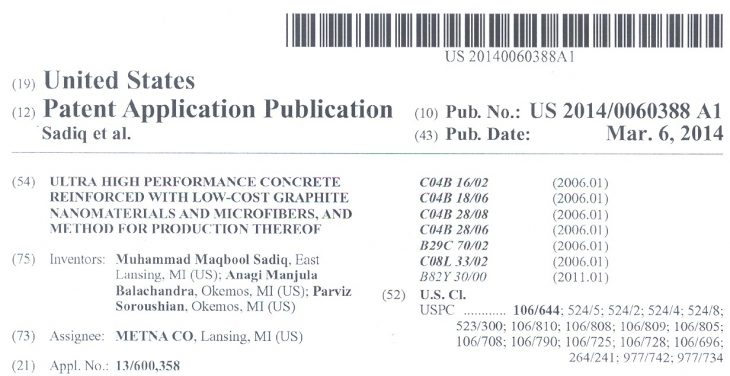
Ultra High Performance (UHP) Concrete : A Revolutionary innovation in construction industry by a Pakistani Scientist
Dr. Muhammad Maqbool Sadiq, a Pakistani scientist has been granted intellectual property rights as the first inventor by U.S Patent office in the form of United States Patent Application Number US 2014/0060388 A1, “ Ultra High Performance (UHP) Concrete Reinforces with Low-Cost Graphite Nanomaterials and Microfibers, and Method for Production Thereof”.
Ultra High Performance (UHP) Concrete is made using suitably functionalized and relatively low-cost carbon nanofibers and graphite platelets. Polyelectrolytes and surfactants are physisorbed upon these graphite nanomaterials in water, and dispersion of nanomaterials in water is achieved by stirring. Stable and well-dispersed suspensions of nanomaterials in water are realized without using energy-intensive and costly methods, and also without the use of materials which could hinder the hydration and strength development of UHP concrete.
The water incorporating dispersed nanomaterials is then mixed with the cementitious matrix and, optionally, microfibers, and cured following standard concrete mixing and curing practices. The resulting UHP concrete incorporating graphite nanomaterials and optionally microfibers offer a desired balance of strength, toughness, abrasion resistance, moisture barrier attributes, durability and fire resistance.
The new Ultra High Performance (UHP) Concrete nanocomposite would be of particular value towards improvement of the safety and reliability of mission-critical infrastructure systems, and would also benefit broader infrastructure systems by providing balanced gains in mechanical, physical and durability characteristics at viable initial cost.
The new Ultra High Performance (UHP) Concrete nanocomposite offer the potential to improve the service life, sustainability and life-cycle economy of concrete-based infrastructure systems, and to bring about improvements in the following properties of concrete: (i) blast and impact resistance; (ii) toughness and energy absorption capacity; (iii) fire resistance; (iv) abrasion resistance; (v) fatigue life; (vi) tensile/flexural strength and crack resistance; (vii) impermeability and durability in aggressive environments; (viii) damage monitoring and self-sensing capabilities.
The above improvements in concrete properties benefit diverse fields of application, including:
- Military shelters and mission-critical structures (requiring enhanced blast, fire, chemical and seismic resistance);
- Hydraulic structures (requiring enhanced impermeability, durability, flexural strength, crack resistance, and abrasion, erosion and impact resistance);
- Water, sewer and nuclear waste containment and infrastructure systems (requiring enhanced barrier qualities, blast, impact, seismic, fire and chemical resistance, durability, flexural strength and crack resistance); and
- Airfield and highway pavements, bridge decks and parking structures (requiring damage monitoring, enhanced fatigue life, abrasion and impact resistance, durability, impermeability, flexural strength and crack resistance)

